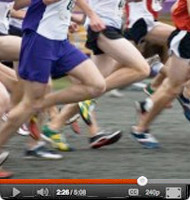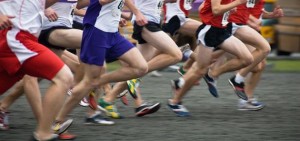
One of our Senior Physiotherapists, Faye Burge, recently attended the Joanne Elphinston Movement Systems course in December 2013. She was drawn to this assessment and rehabilitation course specifically due to her training in Pilates and dance back ground. The course is open to physiotherapists and (even those from the dark side), osteopaths and chiropractors!
With the London marathon nearing, the 13 week training programmes are being dusted off and that faithful pair or trainers are being eyed with suspicion. Faye can use the information from the course and adapt it to the principles of training for the marathon. All too often people see the marathon as a way to get fit but struggle with the concept of pre running training eg, you wouldn’t play rugby without training so why compete in one of the greatest endurance events without being fully prepared? To prevent our task out weighing our (functional) ability, a weight/gym based training programme is normally required so the runner’s support and power doesn’t come from their inert structures such as their bones and ligaments. The likes of Mo Farah and Paula Radcliff don’t just use the repetition of running to improve their performance but strength and conditioning programmes to make sure their joints are up to the task of repetitive loading. A well organised strength and conditioning programme set by one of our resident senior physiotherapists or renowned PT Dan will help you to avoid injury. However, for those that do pick up the odd niggle along the way, Faye and the team are there to support you and guide you quickly back to recovery.
What is JEMS All About?
JEMS is a multi modal approach to assessment which considers the interplay between a variety of internal and external variables such as functional and behavioural factors. The course aims to establish principles of effective movements and give an understanding of normal functional movement mechanics and not through the use of special tests. It will only assess specific muscle groups if a deficit is shown through the motor pattern. For example, a runner with a poor lunge technique may need isolated muscle testing of the quads, gluts and core to derive where a weakness lies.
What Faye really appreciated about the JEMS course is the positive message that, irrespective of age and functional ability people can reduce the stress of their bodies and achieve more effective movement. Looking at the individual through the multi modal approach helped Faye to determine not only the “where” of an injury but the “why” and “how”. Subsequently, to avoid injury we must learn the art of moving beautifully. The beauty of movement is demonstrated by the bodies ability to
• Create and control forces effectively
• Deliver an appropriate level of effort to the task at hand (efficiency).
• Share forces over larger surface areas to (reduce isolated muscle stress)
• Cope with a variety of changes.
Why look at movement as opposed to testing?
Evaluating different movements helps Faye to understand a patients individual strategies when performing a motor task (such as a lunge). From this we can assess whether these strategies are optimal for that patient and their body. By looking at movement as opposed to isolated muscle tests we can identify why a structure might be under pressure and what can be done to relieve it. This of course does not mean that localised tests should be abandoned as they are a necessary part of the objective examination. However, Faye is now highly competent in assessing from a more functional movement approach.
The course focusses on movement dysfunctions. But as long as functional demand (what we are asking our bodies to do) does not exceed our functional capacity (what we are actually capable of) we will remain uninjured.
We can lessen the rate of injury if we are able to increase the bodies ability to cope with the task in hand. However in most cases habitual compensations do develop. This suggests that the individual is poor at adapting their performance to cope with the increased demand. An example of this can be seen in runners. Those that can adapt their running style (heel striker, pose runner) to their environment (speed, distance, terrain) will reduce their rate of injury as their body moulds to each running situation.
Faye’s weekend course has so much more to offer and she has learned so much from attending it. Keep a close eye out for its four further inputs over the next few weeks.




